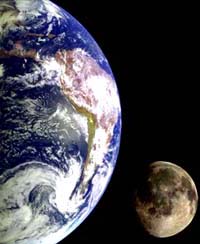| . |  |
. |
 New Analysis Sheds Light On Earth's Origins
New Analysis Sheds Light On Earth's OriginsAnn Arbor - June 1, 2000 - A new analytical method has resolved a longstanding scientific debate on the origins of Earth and the moon, researchers from the University of Michigan and the Swiss Federal Institute of Technology report in the June 2 issue of Science. The debate focuses on a group of primitive meteorites called enstatite chondrites. Because the ratio of different forms (isotopes) of oxygen in materials from Earth and the moon matches that of enstatite chondrites---but no other meteorites---it had been proposed that Earth formed from materials much like the enstatite chondrites. These materials were thought to have come from a very localized region of the solar system. But other studies, such as simulations of how the planets formed, have cast doubt on the theory. Der-Chuen Lee, a research fellow in the U-M Department of Geological Sciences, and Prof. Alex N. Halliday of the Swiss Federal Institute of Technology's Institute for Isotope Geology and Mineral Resources in Zurich, Switzerland, used a recently developed method that compares extremely small differences in tungsten isotope ratios. If Earth and the moon did form from material similar to enstatite chondrites, their tungsten isotopic compositions, as well as their oxygen isotopic compositions, should match. "To our surprise, enstatite chondrites do not have the same tungsten isotopic compositions as Earth," nor do they match any other meteorites that have been tested, says Lee. Based on this evidence, "we propose for the first time with much certainty that there is no direct genetic relationship between Earth and enstatite chrondrites." Instead, the data support the alternative idea that planets, as they formed, received materials from very broad regions of the solar system.
Manoa - May 29, 2000 - Cosmochemistry meteorite studies conducted by University of Hawai'i researchers may help scientists figure out how our solar system formed. UH Manoa Hawai'i Institute of Geophysics director Klaus Keil, postdoctoral fellow Anders Meibom and assistant researcher Alexander Krot studied a rare, metal-rich meteorite dated at about 4.56 billion years old, around the same time the solar system formed.
|
| ||||||||||
| The content herein, unless otherwise known to be public domain, are Copyright 1995-2016 - Space Media Network. All websites are published in Australia and are solely subject to Australian law and governed by Fair Use principals for news reporting and research purposes. AFP, UPI and IANS news wire stories are copyright Agence France-Presse, United Press International and Indo-Asia News Service. ESA news reports are copyright European Space Agency. All NASA sourced material is public domain. Additional copyrights may apply in whole or part to other bona fide parties. Advertising does not imply endorsement, agreement or approval of any opinions, statements or information provided by Space Media Network on any Web page published or hosted by Space Media Network. Privacy Statement All images and articles appearing on Space Media Network have been edited or digitally altered in some way. Any requests to remove copyright material will be acted upon in a timely and appropriate manner. Any attempt to extort money from Space Media Network will be ignored and reported to Australian Law Enforcement Agencies as a potential case of financial fraud involving the use of a telephonic carriage device or postal service. |